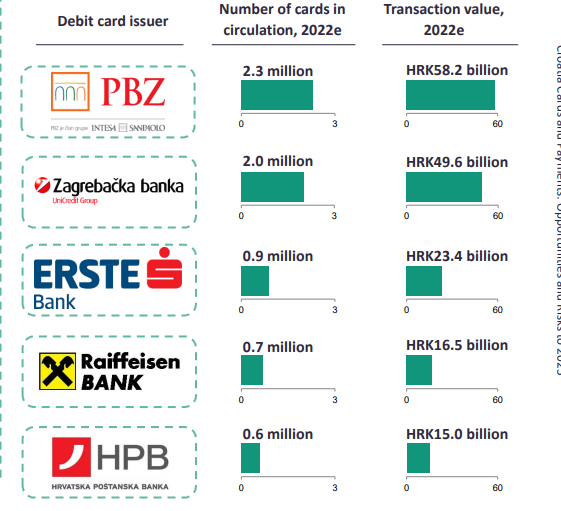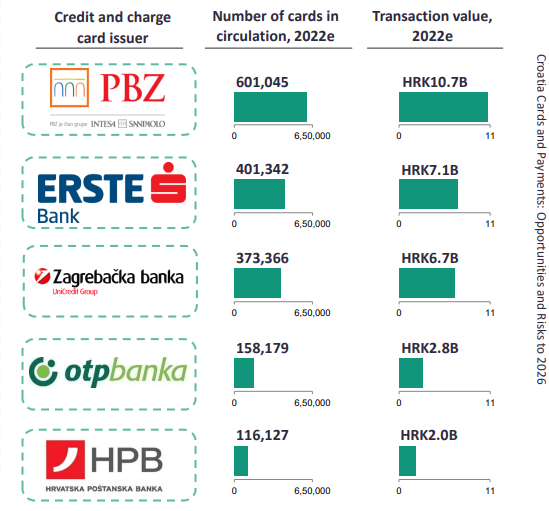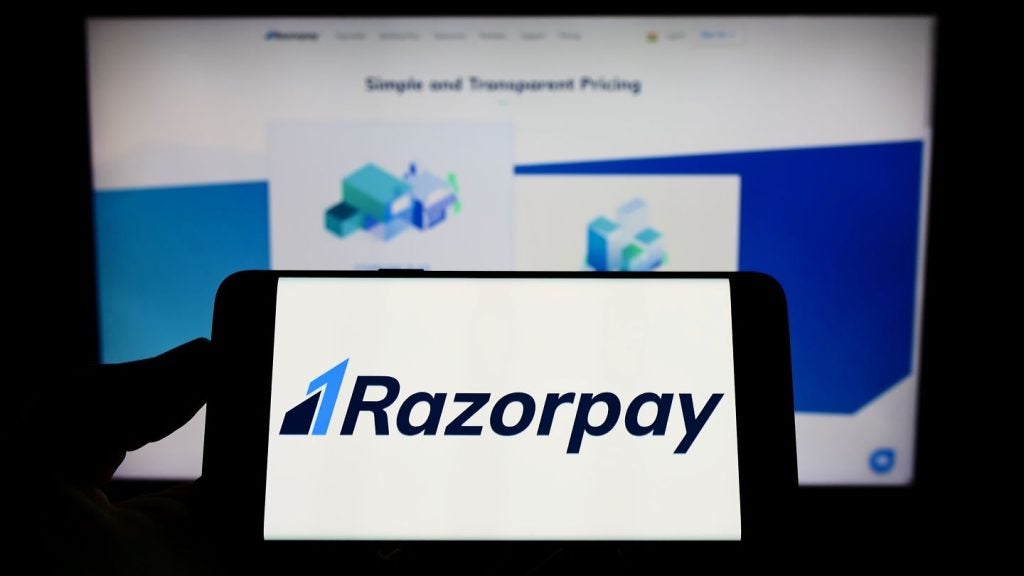Croatians are increasingly adopting payment cards, resulting in an increase in overall payment card penetration and usage in the country. Thanks to Croatia’s improving banking infrastructure and merchants’ increasing acceptance of payment cards, card payment volumes are anticipated to grow at a compound annual growth rate (CAGR) of 9.6% over the period of 2022–26, while card payment value is set to increase at a CAGR of 8.3%. Debit cards lead the way in terms of transaction value, followed by charge and credit cards. This indicates consumers’ desire to avoid debt. In the coming years, the growth of the Croatian payment market will be supported by the emergence of digital-only banks, the growing preference for contactless technology, and the strengthening of the ecommerce market.
Croatians are increasingly embracing alternative payment methods such as PayPal, Apple Pay, and Google Pay, as well as other innovative solutions such as cashier-less stores and wearable payment devices. However, soaring inflation, economic instability, and geopolitical uncertainty will present challenges for the industry.
The Croatian card penetration rate is more than two cards per adult, mainly because of the country’s high banked population. Despite high penetration, card usage frequency in Croatia is among the lowest compared to its peers, reflecting the dominance of cash for payments. However, with improving banking infrastructure, lower interchange fees, and wider merchant acceptance of payment cards, the volume and value of card payment is expected to record (2021–25) compound annual growth rates (CAGRs) of 11.7% and 10.1% respectively.
Debit cards lead the way in terms of transaction value, followed by charge and credit cards. This indicates consumers’ desire to avoid debt. The emergence of digital-only banks, the growing preference for contactless technology, and a rising ecommerce market will also support the payment market going forward. The Covid-19 outbreak has further propelled the adoption and usage of cashless payment methods in the country. While the pandemic has impacted consumer spending, there has been a rise in payment card transactions at the expense of cash.
Debit cards dominate card payments
Debit card penetration in Croatia stood at 176.9 per 100 individuals in 2022e, the second-highest rate among its peers, namely Russia (211.2), Slovenia (126.7), the Czech Republic (124.5), Slovakia (100.6), Poland (97.5), Bulgaria (96.6), Romania (91.2), and Hungary (90.1). Croatia’s high card penetration rate can be attributed to the country’s strong banked population, which stood at 92.4% in 2022e, in addition to the government’s financial inclusion measures.
In 2022, debit card payment frequency rate in Croatia was estimated at 64.2 transactions per card per year. This compares to 217.2 in Poland, 184.6 in Russia, 160.9 in Hungary, 146.8 in the Czech Republic, 128.8 in Slovakia, 92.1 in Slovenia, 87.2 in Romania, and 40.3 in Bulgaria.

US Tariffs are shifting - will you react or anticipate?
Don’t let policy changes catch you off guard. Stay proactive with real-time data and expert analysis.
By GlobalDataIn 2022, card payment turnover per debit card in Croatia was estimated at $1,904. This compares to $4,580 in the Czech Republic, $4,295 in Russia, $4,169 in Hungary, $3,531 in Poland, $3,492 in Slovenia, $3,438 in Slovakia, $2,510 in Romania, and $1,271 in Bulgaria.
Croatia: debit card market shares

Credit and charge cards are gradually gaining traction
Credit and charge card penetration in Croatia is low at 44.9 cards per 100 individuals in 2021 – which is still higher than its peers. Covid-19 restrictions resulted in reduced consumer spending, which in turn affected the use of credit and charge cards, resulting in the market contracting by 8.7% in terms of payment value in 2020. However, with the gradual revival of economic conditions, value is set to have increased by 2.6% in 2021. With banks offering credit and charge cards in bundled packages, as well as providing various value-added benefits, the market is set to record CAGR of 3.6% for the 2021-2025 period.
Croatia: Credit and charge card market shares

Covid-19 has boosted ecommerce growth
Ecommerce payments in Croatia are estimated at HRK7.1bn ($1.2bn) for 2021, up from ($0.7bn) in 2017. Rising internet and mobile penetration, increasing consumer confidence in online transactions, and the convenience offered by online shopping are all key drivers of ecommerce growth. Growth has also been driven by Covid-19, which caused a shift in consumer buying behaviour from offline to online. This resulted in the ecommerce market rising by 14.8% in 2020 – much higher than the 8.9% growth recorded in 2019.
Prepaid card uptake expected to gradually increase
The prepaid card market is at a nascent stage of development in Croatia. Despite low penetration, the market recorded growth in terms of transaction value with a CAGR of 2.5% between 2017 and 2021. To capitalise on ecommerce growth, banks in Croatia are offering prepaid cards exclusively for online shopping. OTP Bank issues the Visa Web prepaid card, which is linked to Visa Web accounts. The card includes insurance in collaboration with Croatia osiguranje, which protects card holders from card theft or misuse. To increase card uptake, banks offer prepaid cards targeted at young individuals. HPB offers IDEEEŠ!, a Visa prepaid card for children that can be used for travel and collecting pocket money. The card features contactless functionality and does not charge any monthly fees.
Card acceptance infrastructure is developed in Croatia
The number of POS terminals registered a CAGR of -3% between 2017 and 2021, decreasing from 118,621 in 2017 to 104,947 in 2021. Despite this decline, POS adoption in Croatia is high with one POS terminal for every 38 individuals. Retailers are increasingly upgrading or replacing their POS terminals to incorporate contactless. The number of POS terminals with contactless functionality rose from 80,884 in December 2019 to 83,204 in December 2020, accounting for 77% of total POS terminals.
The adoption of low-cost mobile terminals is also on the rise, particularly among SMEs. According to the central bank, 1,071 Croatian merchants had a mobile POS or virtual POS terminal installed as of December 2020. UK-based myPOS offers a range of POS devices, including myPOS Smart – a mobile-based POS acceptance solution.







